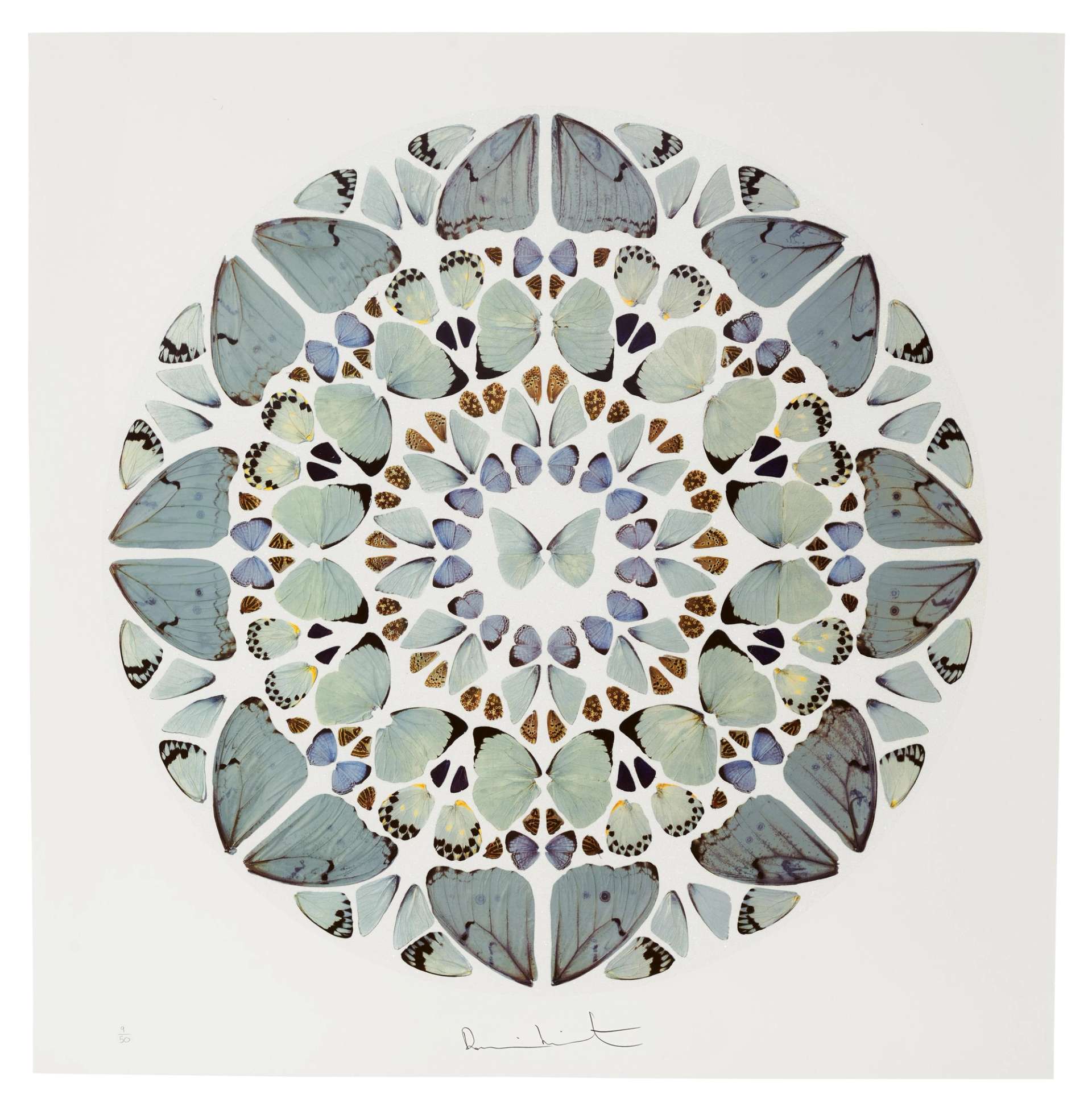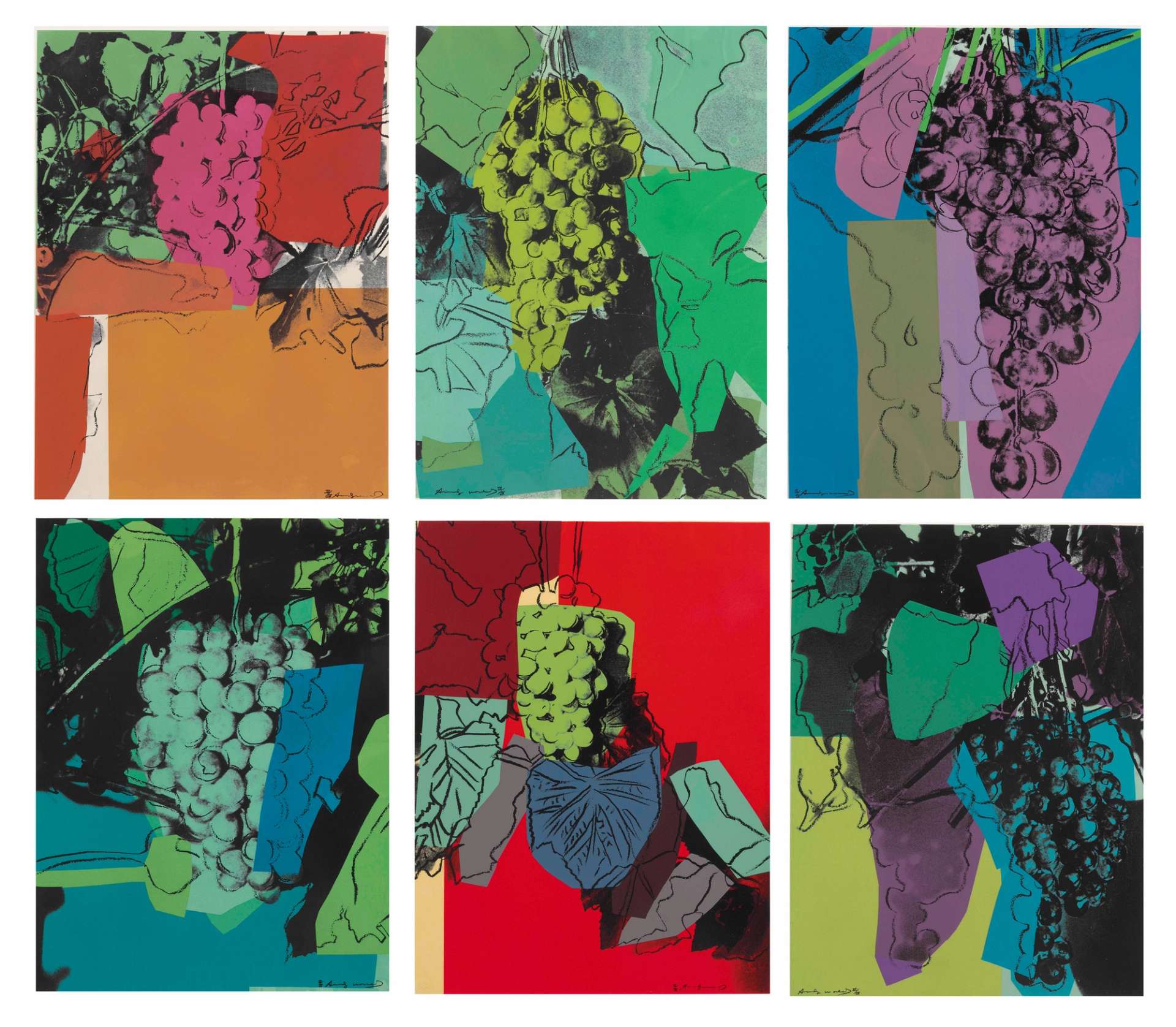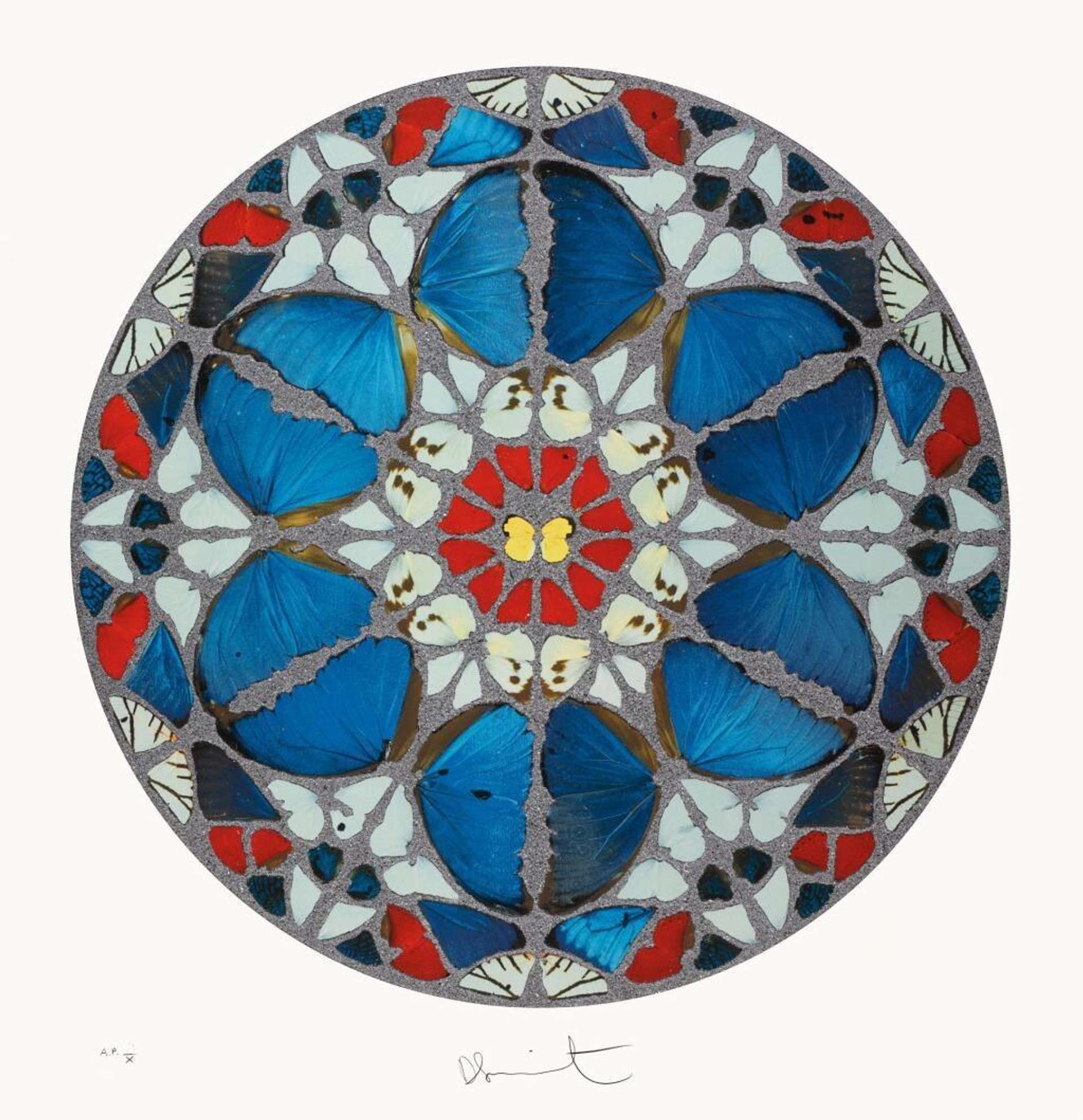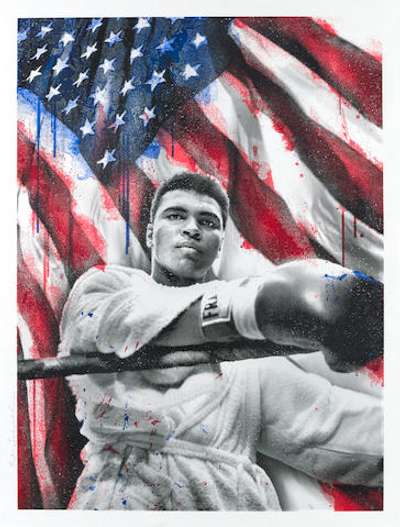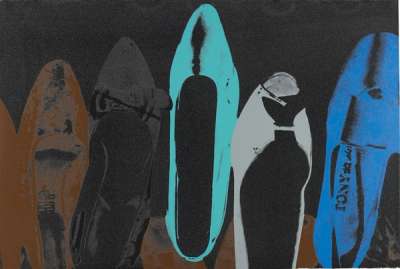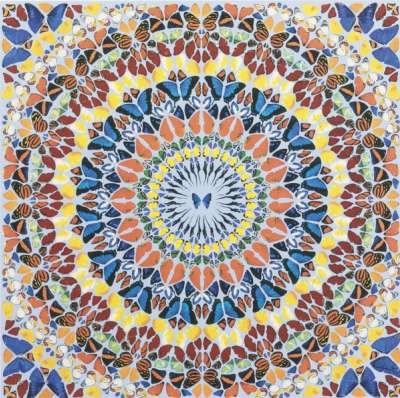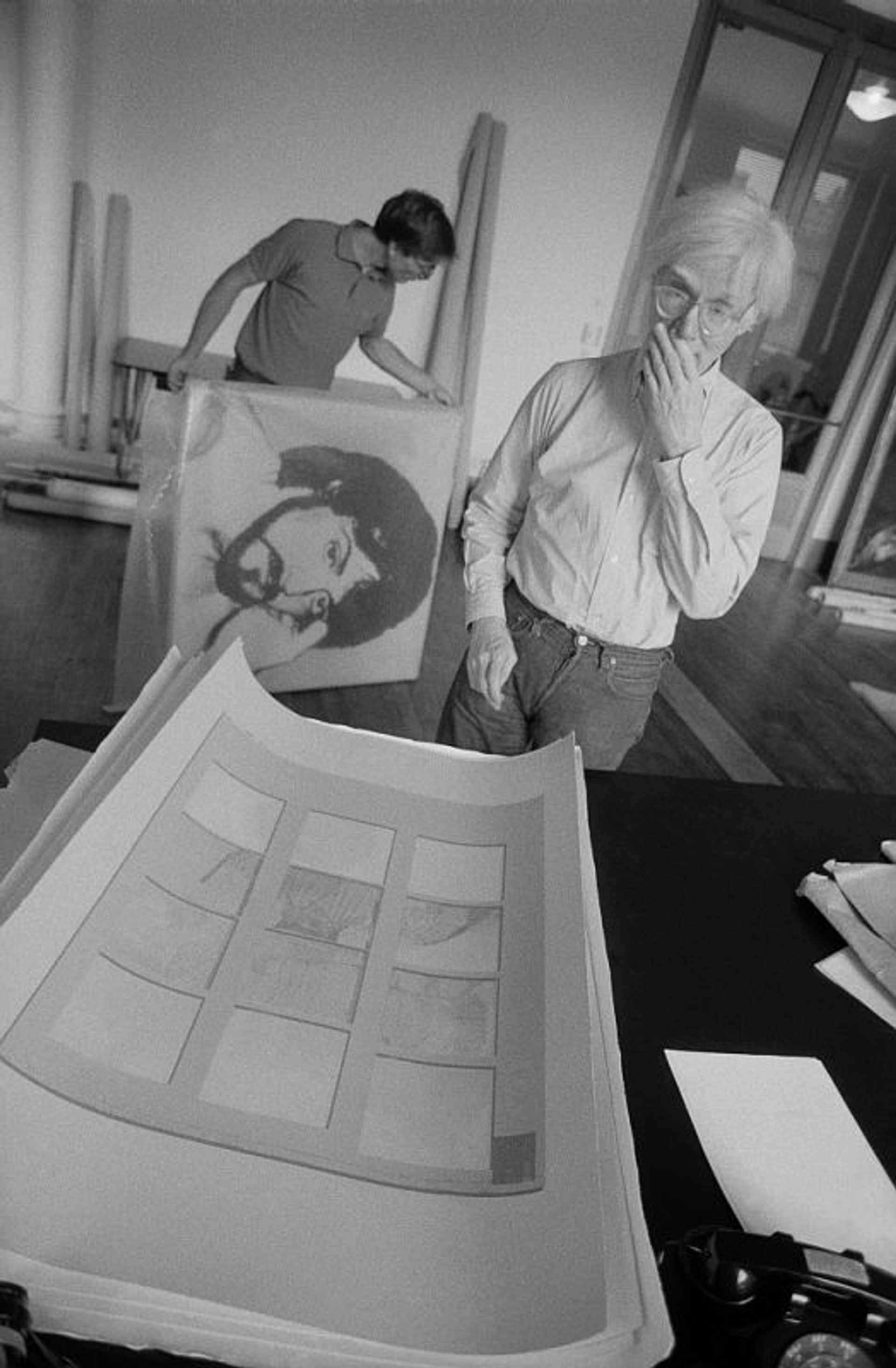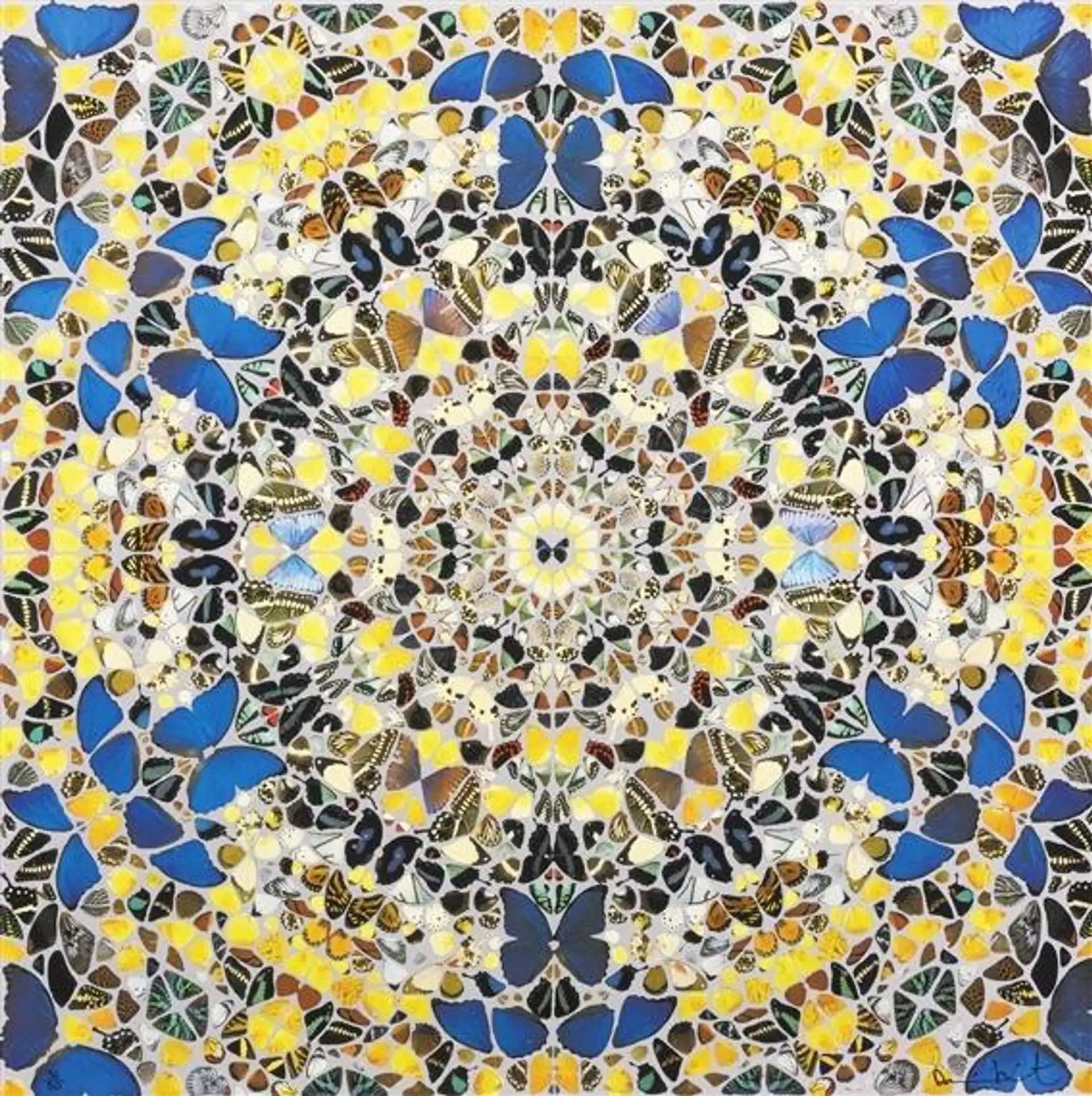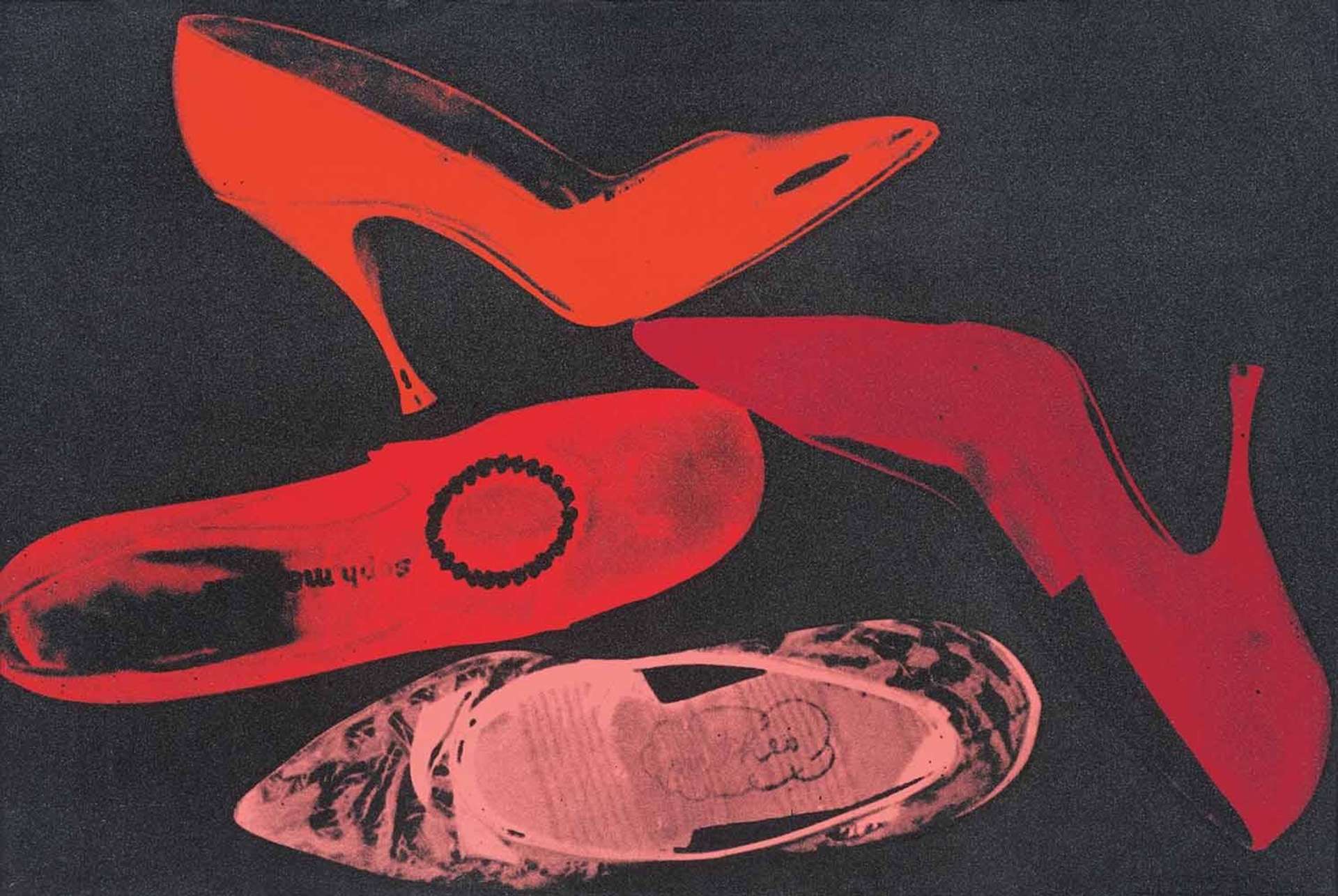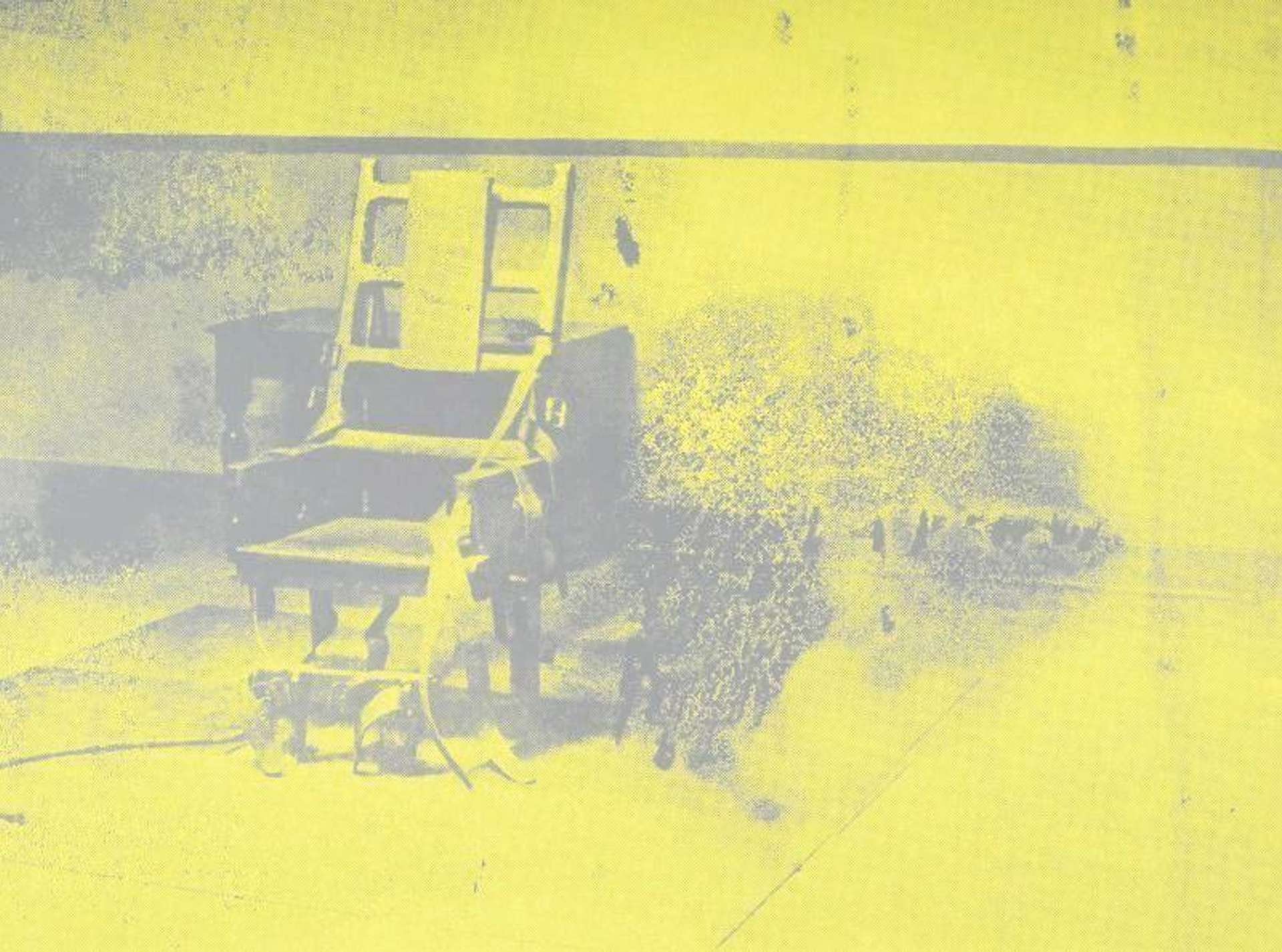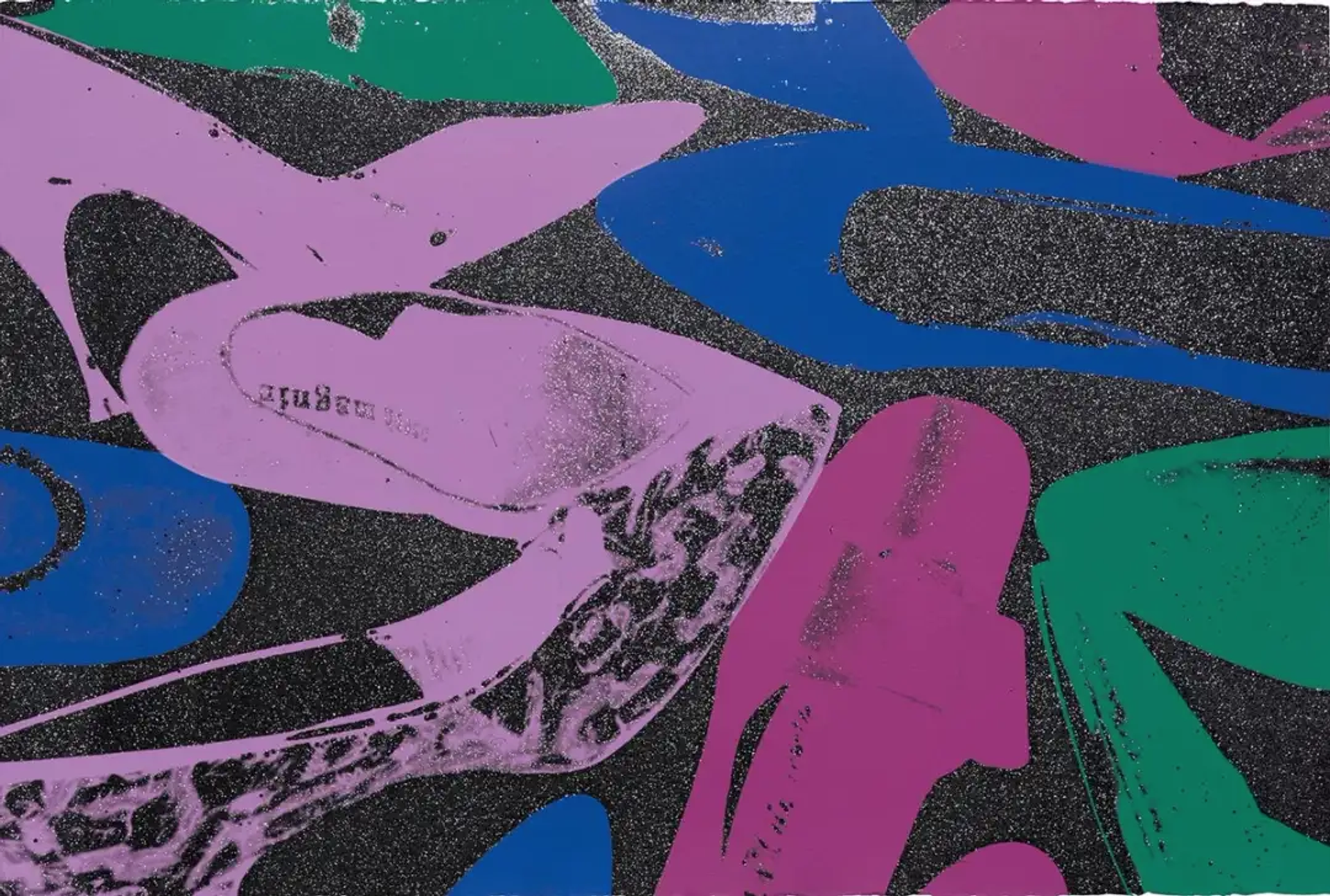 Diamond Dust Shoes (F. & S. II.254) © Andy Warhol 1980
Diamond Dust Shoes (F. & S. II.254) © Andy Warhol 1980Now becoming increasingly common, diamond dust is a material that has transcended its association with luxury to become a significant medium in modern artistry. From the glitzy Pop Art of Andy Warhol to the contemplative creations of Damien Hirst, discover how diamond dust has evolved in both aesthetics and themes. Artists have each infused this sparkling substance with a unique blend of opulence and profound artistic expression, using it to reflect on themes of glamour, human nature and mortality.
What is Diamond Dust?
In the realm of art, the use of diamond dust presents a blend of opulence and technical complexity. Contrary to popular belief, a majority of what is termed as 'diamond dust' in artistic contexts is not made purely of diamonds, but rather a combination of materials. Diamonds are, of course, highly valuable so the art industry’s use of actual diamonds is rare due to their cost and significance. In the jewellery sector, less than 20 percent of mined diamonds are of a quality suitable for crafting into gems. The remainder, often referred to as lower-grade diamonds, find extensive use in various industrial settings, including mining and technology industries.
These lower-grade diamonds, less lustrous and with more imperfections, are typically ground into dust. This diamond dust is then sorted into different batches based on grain size. In its primary form, diamond dust is an abrasive powder, commonly employed in the creation of grinding wheels, polishing pastes, and even in the technology sector as a coating for integrated circuits. Given its wide range of utilitarian applications, acquiring pure diamond dust for artistic purposes is a challenging endeavour. As a workaround, artists often use a composite material made from a mixture of glass, diamonds, and other clear substances to mimic the appearance and texture of pure diamond dust.
Working with Diamond Dust
When sourcing diamond dust, artists have the option to choose from various grain sizes, ranging from fine to coarse, and even select specific colours. However, the most commonly used form is clear diamond dust, which is prized for its unique kaleidoscopic sparkle effect. This dazzling quality is a key reason artists incorporate diamond dust into their works.
The application of diamond dust in art is a delicate process. During the printing phase, instead of a traditional ink layer, a special adhesive is applied to the artwork. The artist must then swiftly sprinkle the diamond dust onto the adhesive surface before it dries, a task that requires precision and speed. Once adhered, diamond dust creates a robust and enduring finish, contributing to the longevity and unique visual appeal of the artwork.
Over the years, the use of diamond dust in art has evolved, with artists exploiting its unique properties to create works that shimmer with a life-like quality, adding depth, texture and a sense of luxury to their creations. Despite its non-traditional nature, diamond dust has established itself as a surprisingly durable and captivating artistic material, enduring over several decades and continuing to dazzle artists and audiences alike.
Andy Warhol: Reflecting Glamour with Diamond Dust
A leading figure in the Pop Art movement, Andy Warhol is renowned for his innovative use of everyday consumer goods and celebrity images to create art that both reflected and critiqued contemporary culture. His incorporation of diamond dust into his artwork was a natural progression of his artistic exploration, seamlessly blending glamour, allure and luxury – themes that were ever-present in his work. Warhol's use of diamond dust aligned perfectly with the foundational concepts of his art. He was fascinated by fame and the opulence associated with celebrity culture. His choice to use diamond dust was more than just a stylistic preference; it was a symbolic gesture that echoed the themes of extravagance and superficiality prevalent in his work. Diamond dust, with its inherent connotations of wealth and luxury, was the ideal medium for Warhol to further express these themes.
In Warhol's hands, diamond dust transformed into an embodiment of the glitz and glamour of the high society and celebrity world that he was so often depicting. By incorporating diamond dust into his portraits of iconic figures and consumer goods – notably in the Diamond Dust Shoes series – he was able to elevate the status of his subjects, imbuing them with an ethereal and almost untouchable quality. This technique not only enhanced the visual appeal of his art but also deepened its commentary on the societal obsession with luxury and fame. Warhol’s diamond dust pieces are characterised by their sparkle, which draws viewers in, only to confront them with the underlying critique of materialism and the ephemeral nature of celebrity status. The glittering surface of these works contrasts sharply with the often mundane or commercial nature of the subjects, creating a juxtaposition that is quintessentially Warhol – a blend of the everyday and the extraordinary. His work questioned the boundaries between the elite world of art and the accessible realm of popular culture.
Warhol's integration of diamond dust in his art was a masterstroke that perfectly encapsulated the essence of his artistic vision. It allowed him to create pieces that were visually stunning and rich in symbolism, critiquing and celebrating the glamour and luxury he observed in contemporary culture. Warhol's pioneering use of diamond dust not only enhanced the aesthetic value of his art but also reinforced his ongoing exploration of fame, materialism, and the commodification of culture.
Damien Hirst: Reinventing Diamond Dust in Modern Art
Damien Hirst, a prominent figure in the contemporary art world and a leading member of the Young British Artists (YBAs), has been known for his provocative and often controversial works. His approach to the use of diamond dust in art marked a departure from the practices of predecessors like Warhol, embodying a new phase in the evolution of this unique material in the art world. Hirst's work with diamond dust is emblematic of his broader artistic endeavours, which often explore themes of life, death, and the transient nature of human existence. Unlike Warhol, his use of diamond dust is not merely for the sake of glamour or luxury but is often imbued with deeper, sometimes darker, meanings.
In Hirst's hands, diamond dust becomes a tool to challenge and explore the dichotomies of existence: beauty and decay, wealth and mortality, eternity and ephemerality. This is evident by the inclusion of the material in many of his artworks, including in the series The Empresses and Psalms. One of the most striking aspects of Hirst's use of diamond dust is his ability to contrast its inherent opulence and durability with motifs that evoke mortality and existential contemplation. For instance, in some of his works, he combines diamond dust with images or sculptures of skulls, a stark memento mori. In another example, he uses it to cover hus butterfly-wings mandala, a juxtaposition between incredibly frail and remarkably durable materials. This creates a powerful commentary on the human pursuit of wealth and beauty in the face of the inevitable reality of death.
Hirst’s technique in applying diamond dust also demonstrates a departure from traditional methods. He often experiments with different textures and combinations, sometimes mixing diamond dust with other materials to create unique visual effects. This experimental approach not only showcases the versatility of diamond dust as a medium but also reflects Hirst's constant push against the boundaries of conventional art practices. His works prompt viewers to question what it is that imbues an object with value - is it the material worth, the artist's name, the art itself, or some combination of these factors?
While his approach to using diamond dust in modern art continues the tradition of using this material to add a dimension of luxury and allure, Hirst elevates its use to new heights, infusing his works with profound symbolic meaning. His innovative techniques and thought-provoking themes reinvent the use of diamond dust, making it not only a tool for aesthetic enhancement but also a powerful medium for exploring the deeper questions of mortality, human existence and the nature of art itself.
Other Artists and The Evolution of Aesthetics and Themes in Diamond Dust Art
The aesthetic evolution of diamond dust art is marked by a transition from mere opulence and glamour to a more nuanced exploration of themes. It has not only added a physical dimension to the artworks but also enriched the thematic depth and aesthetic diversity of modern art. From Warhol's glitzy pop art to Hirst's existential explorations, diamond dust has been a versatile and dynamic medium, shaping and being shaped by the artistic visions of those who use it. The material has since been adopted by a variety of artists, each bringing their unique perspective and thematic focus.
Russell Young, for example, has used diamond dust to create large-scale, glittering screen prints that often revisit iconic moments and figures from American history and popular culture. His work resonates with a sense of nostalgia while highlighting the enduring fascination with fame and celebrity, a theme that is accentuated by the luxurious sheen of diamond dust. Peter Blake, another artist who has incorporated diamond dust into his work, is known for his contributions to the Pop Art movement. Blake’s use of diamond dust adds a layer of depth and texture to his pieces, creating a bridge between the artwork and the viewer through its interactive, light-catching properties. His works often feature a playful and whimsical approach, combining everyday images with the grandeur imparted by diamond dust. Shepard Fairey, widely known for his Obey Giant campaign and the iconic Hope poster of Barack Obama, has also experimented with diamond dust in his work. Fairey's use of this material adds a refined dimension to his often politically and socially charged artwork, creating a contrast between the gritty themes of his work and the luxurious connotations of diamond dust.
The Future of Diamond Dust in Art
The thematic journey of diamond dust in art reflects a broader narrative about the evolving nature of luxury, fame, and material value in modern society. While initially used to underscore the glamour of the subjects, diamond dust has become a medium for artists to comment on a range of issues, from the fleeting nature of fame to the complexities of societal values and of life itself. The evolution of aesthetic and themes in diamond dust art is a testament to the material's adaptability and potency as an artistic medium. From enhancing the glamour of pop art to enriching the thematic depth of contemporary works, diamond dust continues to sparkle in the art world, capturing the imagination of artists and audiences alike.


